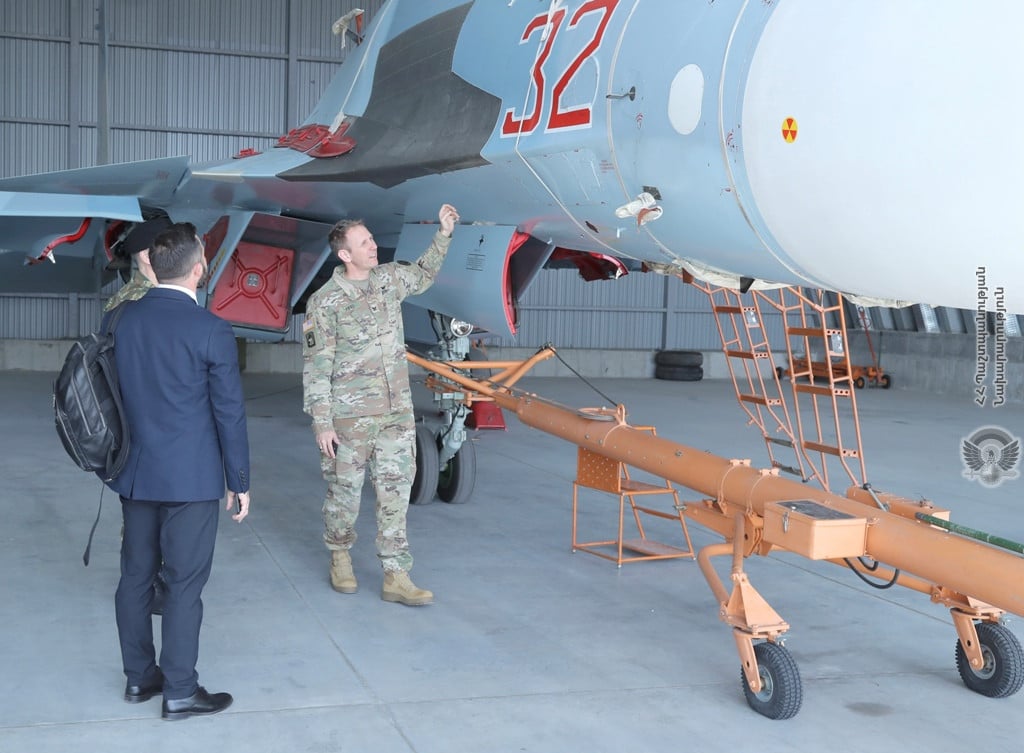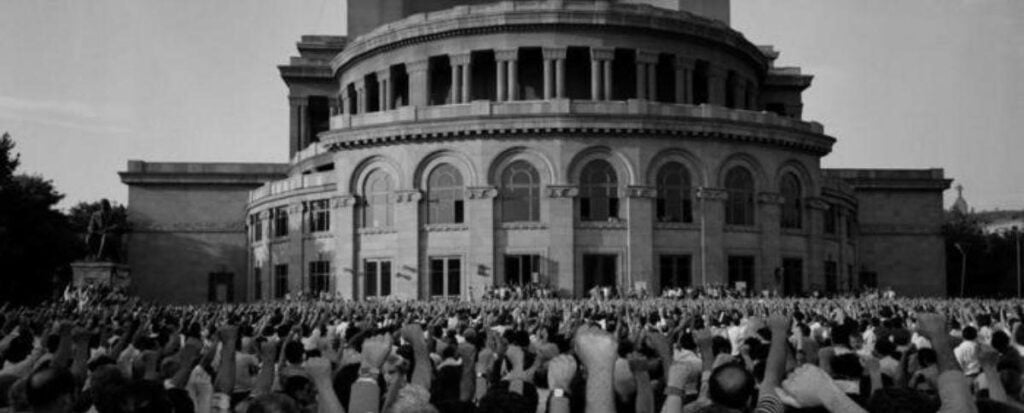
During the last few months, in the information warfare Azerabaijan is actively presenting Armenia as the participant or supporter of Russia’s aggression. Manipulative claims and fake news are deployed to make an impression that Karabakh conflict and the Russian-Ukrainian war carry the same nature, with Azerbaijan and Ukraine being the victims, and Armenia and Russia – the aggressors.
However, the Russian-Ukrainian war and the conflict between Armenia and Azerbaijan have different root causes and progression, and the issue of security of Karabakh Armenians can never be identified with the occupation of Ukraine’s territories by a superpower.
In defiance of these differences, certain countries draw parallels between these two conflicts maintaining Armenia an aggressor like its ally Russia, and making Azerbaijan a victim like Ukraine. For instance, Nika Gvaramia, one of Georgia’s opposition leaders, declared that “Karabakh, just as Ossetia and Abkhazia, are occupied by the Russian-Armenian tandem.” This same narrative is furthered by Azerbaijani organizations and individuals. In the meanwhile, in Ukraine, referring to the Azerbaijani sources, they not only compare both conflicts, but also claim that Azerbaijan is not an aggressor, but rather a victim.
Besides, Azerbaijan puts different resources into motion to shape Armenia’s anti-Ukrainian and pro-Russian image to represent it as a threat to energy security and the values of the West.
“Russia backs Armenia in the war”
Despite that official Yerevan has been taking a neutral stance since the very first day of Ukrainian war, yet much efforts are exerted by various forces to carve Armenia’s pro-Russian image. With the help of episodic actions, the reality is distorted to leave an impression that Russia’s military operations find massive support.
The first attempt of support took place on the fourth day of Russian invasion, when a poster with the text “Армия России” (Army of Russia) was hung from the Kievyan bridge in Yerevan only for 9 minutes by several individuals, and the video was spread on social networks for days attempting to prove Armenia’s support.
If the organizers of the action were unknown this time, a few months later, the organizers of an action exhibiting a huge poster with Putin’s photo to mark the birthday of Russia’s president first in Stepanakert, then in Yerevan, turned out to be a pro-Russian group.
Media.am has already addressed other similar episodes, in the meantime pinpointing the fact that pro-Russian actions are quickly swept across the web, while the actions in support of Ukraine, go unnoticed.
This was accompanied with emergence of false facts on Armenia allegedly seconding Russian military operations. For example, British BBC relied on an Azerbaijani source to make an unfounded claim that Russia has moved mercenaries from Syria to Ukraine allegedly using Armenia as a transit country. The British media did not take into account that the source it used, Haber Global, had already spread other fake news related to Armenia in the context of Ukrainian war.
In one case it made a claim that Armenia has delivered SU-30SM fighter aircrafts and pilots to Russia. The allegation was completely groundless, yet considering its prevalence, the Armenian authorities had to refute it, and the military attachés of the EU and NATO member states accredited in Armenia were to physically come and eyewitness that the fighters were intact. In another case the Azerbaijani Haber Global reported about Russian peacekeeping forces taken out of Nagorno Karabakh to fight against Ukraine. This was yet another fake news: the peacekeepers were and are still in Karabakh.
Along with this, fake news about Ukraine-Azerbaijan tandem were sweeping Armenia. For example, the news about actions taking place in Azerbaijan and Ukraine on April 24 under the motto “Zangezur is Azerbaijan” was insinuated by Azerbaijani sources to Armenia. As it turned out, these actions were old and had other causes. Another claim already refuted, was being circulated, which referred to Ukraine selling white phosphorus to Azerbaijan.
Antagonization of Armenia in the eyes of West
Azerbaijan uses its information resources to antagonize Armenia in the eyes of western auditorium. This country has created media resources imitating to be Armenia, while carrying forward anti-Armenian propaganda. The same content is shared by pro-Azerbaijani lobbyists.
One of such resources to be mentioned is the Armenianreport website, publishing an anti-Semitic article purportedly penned by an Armenian columnist in October 2022, arguing that Armenia should develop relations with Arab states, first of all Palestine, because Israel and Jews are “greedy” and “mercantile”, and have interest only in rich Azerbaijan.
The article fabricated on the most widespread anti-Semitic stereotypes coupled with an anti-Semitic caricature. Media.am addressed that article reminding that Armenianreport is used more as a weapon of information war rather than a news media.
To blame Armenia in nazism, this article has been widely circulated by pro-Azerbaijani lobbyists, including Michael Doran, American analyst. Every time he tweets on regional news in his microblog, he reminds that Armenia is Iran’s ally, Russia’s satellite.
In the context of equating Ukraine-Russia and Armenia-Azerbaijan conflicts, one of the pro-Azerbaijani lobbyists Brenda Shaffer, who worked as an advisor to the president of the Azerbaijani state oil producer SOCAR, is quite active. She claims that the United States should assist Azerbaijan in the same way it does Ukraine. Likewise, she is vigorously spreading the Azerbaijani propaganda that Armenia is a threat to the energy supplied by Azerbaijan to the Europe. In September, during the attack of Azerbaijan on Armenia, she made a claim that “each time Azerbaijan plans to increase gas exports to Europe, conflict emerges.”
Furthermore, one of the arguments to back the splitting up into Armenia-Russia, Azerbaijan-West camps, is Armenia’s membership to the Collective Security Treaty Organization (CSTO) established by Russia. On the other hand, the declaration made by the Azerbaijan president Ilham Aliyev, that “the number of our friends in CSTO is higher than those of Armenia” comes to prove the manipulative nature of that propaganda.

The grounds of the Russian-Ukrainian war lie in the annexation of the territories of neighbor countries, whereas the mass democratic movement often deemed in Armenian historiography as one of the signals of the collapse of the USSR, underlies Karabakh conflict.
There are three fundamental differences between the Karabakh and Russian-Ukrainian war:
1. The basis of Karabakh conflict was the democratic movement, which the authorities of both the USSR, as well as those of the Soviet Armenia, were attempting to suspend.
In the late 1980-s, with the USSR Glasnost (openness), implying more loosened censorship and untied freedom of speech, the discrimination and oppressions against ethnic Armenians, who made the majority of Nagorno Karabakh, practiced by Azerbaijani authorities, gained active deliberations across the Soviet press and among Armenian intellectuals.
In February 1988, the Karabakh Movement took its start in Yerevan with the claim to include NK in the Armenian SSR. This movement was both nationalistic and at the same time democratic. Mass protests with the participation of hundreds of thousands, were taking place in Yerevan and Stepanakert under the motto “Unification.” Soon after, the demonstrators were joined by small and large enterprises, the workers announced strikes, and special Strike committees were set up in certain enterprises.
However, these demonstrations were not welcomed by the authorities of either Moscow, or Yerevan. Addressing people, First Secretary of the Soviet Armenia Karen Demirchyan said that the demands of NK contradict the interests of Armenia and Azerbaijan.
The demonstrations were received exceedingly negatively in Azerbaijan landing on clashes between two nations. From February 27 to March 1, massacres of local Armenians take place in the Azerbaijani city Sumgait. The situation is resolved only after the intervention of the USSR Army.
Soviet authorities were trying to put off the demonstrations of Armenians first with pleas, and later on with banning the gatherings. However, the demonstrations went on throughout the entire period of 1988 both in Yerevan, and in Stepanakert. The authorities of NK were making a reference to the principle of nations’ self-determination stipulated in the Constitution of USSR and calling for unification with Armenia.
In the meanwhile, clashes between Armenians and Azerbaijanis carried on. By the end of 1988 hundreds of thousands Armenians and Azerbaijanis were forced to leave their houses in Azerbaijan and Armenia: both countries “cleansed” their territories from unwanted ethnic minorities.
2. The demand to joint Nagorno Karabakh to the Armenian SSR was not a territorial dispute between two sovereign states, but rather a call to change the autonomous status of an entity within the USSR.
The majority Armenian population of the Nagorno Karabakh Autonomous Oblast made a number of attempts to raise the issue of joining to Armenia. Since 1940-ies, the local Armenians had filed petitions to Soviet authorities for a number times pleading to secede them from Soviet Azerbaijan.
The pick of this process was the movement of 1988. Both the central apparatus of USSR and the Azerbaijani SSR failed to solve the issue and responded to the peaceful demonstrations with violation.
As a result of the collapse of the USSR in 1991, all 15 states gained independence, and their autonomous territorial units were recognized as the sovereign territory of those states. Thus, Nagorno-Karabakh lost its autonomous status and was internationally recognized as part of Azerbaijan.
The violations emerging in 1988 went out of control after the collapse of USSR turning into a war lasting for years, and into a hostility enduring for decades now.
3. Nagorno Karabakh has never been annexed. Moreover, Armenia has never recognized its independence.
The commencement of Russian-Ukrainian military conflict was perhaps the annexation of Crimea by Russia, ratified by the agreement signed in March 2014. And in 2022, days before the attack, Russia recognized the so-called Republic of Donetsk and the Republic of Luhansk. This way, Kremlin not only occupied Crimea, the territory of Ukraine, but added up with recognizing the independence of separatist groupings in Crimea.
In the case of Nagorno Karabakh, Armenia did not act the same way. The country self-recognized as an independent republic and had actual governance institutes – a President, Parliament, Ministries etc. The connection with Armenia of course played a strong role in this case: Armenia was providing Karabakh with resources, the locals carried Armenian passports. Both in Karabakh and in Armenia the nationalist narrative was heavy-duty in that NK should be part of Armenia.
Yet, Karabakh was not adjoined to Armenia legally. This means that NK has never been annexed by Armenia.
In the negotiation process with Azerbaijan Armenia aimed to gain clarification of NK status – extensive autonomy and security guarantees for the local Armenian population. The officials in Yerevan and Stepanakert were talking about independence in an effort to further this agenda on international platforms.
In fact, Armenia never recognized the independence of Karabakh, i.e. Armenia did not recognize the existence of Nagorno Karabakh outside Azerbaijan.
Arshaluis Barseghyan
Karine Ghazaryan

Add new comment
Comments by Media.am readers become public after moderation. We urge our readers not to leave anonymous comments. It’s always nice to know with whom one is speaking.
We do not publish comments that contain profanities, non-normative lexicon, personal attacks or threats. We do not publish comments that spread hate.